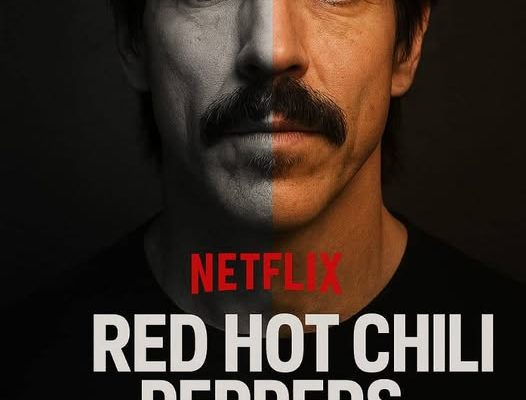Netflix has finally pulled the curtain back on one of the most anticipated music documentaries of recent years, and the world is buzzing with excitement. The streaming giant has officially released its long-awaited documentary on the Red Hot Chili Peppers, the legendary Los Angeles band that has not only shaped the sound of alternative rock for more than four decades but has also managed to remain culturally relevant across multiple generations. For fans, critics, and music lovers alike, this release is more than just another title added to Netflix’s catalog; it is an immersive journey into the turbulent, raw, and often extraordinary world of one of rock’s most iconic bands.
The Red Hot Chili Peppers’ story has always been larger than life. From their humble beginnings as a quirky funk-punk act in the streets of Los Angeles to becoming one of the biggest stadium-filling rock bands in the world, the group’s rise has been filled with triumph, tragedy, reinvention, and resilience. The documentary, which had been whispered about for years and frequently delayed due to production challenges, finally provides fans with an unfiltered look at the group’s history. The film draws on rare archival footage, intimate interviews, behind-the-scenes glimpses of studio sessions and tours, and never-before-seen personal moments that strip away the myth to reveal the human beings beneath the music.
What makes this release particularly special is the timing. The Red Hot Chili Peppers have long been recognized as a band that has defied the odds. They emerged in the 1980s Los Angeles music scene, a period dominated by hair metal and punk rock, carving out a space of their own with a unique blend of funk grooves, punk energy, and psychedelic undertones. Their eccentric style, shirtless stage antics, and blistering energy made them stand out immediately. Yet, unlike many of their contemporaries, they didn’t fade into obscurity when the trends shifted. Instead, they adapted, reinvented themselves, and wrote music that would become anthems for millions around the globe. The documentary captures this evolution in a way that feels both authentic and celebratory.
Netflix’s film digs deeply into the personal lives of the band members—frontman Anthony Kiedis, bassist Flea, drummer Chad Smith, and the enigmatic guitarist John Frusciante. Each of these figures has a story worthy of its own film, but together, they form the collective soul of the Red Hot Chili Peppers. Anthony Kiedis, with his charismatic stage presence and deeply autobiographical lyrics, has always worn his heart on his sleeve, tackling themes of addiction, love, and personal growth. Flea, the high-energy bassist whose funky playing style is as distinctive as his eccentric personality, has long been the glue of the band. Chad Smith, whose powerhouse drumming anchors the group’s sound, has been both the rhythmic backbone and comic relief in the band’s story. And John Frusciante, the prodigious yet fragile guitarist, has come and gone from the band multiple times, but each return has been marked by some of their most creative and successful work. The documentary handles these personal arcs with care, never shying away from the darker chapters of drug addiction, death, and internal conflict, but also celebrating the resilience that allowed the band to continue.
Perhaps one of the most emotional aspects of the documentary is its coverage of the band’s struggles with addiction. Both Kiedis and Frusciante have had well-documented battles with drugs, battles that nearly ended not only their careers but also their lives. The film provides harrowing yet inspiring detail about these periods, using firsthand accounts and haunting footage to underscore just how close the Chili Peppers came to self-destruction. Yet, it is precisely through these struggles that some of their most powerful music was born. Songs like “Under the Bridge” are imbued with a sense of raw vulnerability that resonates deeply with fans, and seeing the story behind such music makes the listening experience even more profound.
The documentary also highlights the tragedies that shaped the band, most notably the death of founding guitarist Hillel Slovak, who passed away in 1988 from a heroin overdose. Slovak’s death nearly ended the Red Hot Chili Peppers before they truly began, but instead, it became a turning point. The pain of losing their bandmate and friend forced the group to reevaluate their direction, leading to new creative horizons and eventually the arrival of John Frusciante, who would go on to help shape their most iconic sound. This cycle of loss, healing, and rebirth is presented with poignant storytelling, leaving viewers with a deeper understanding of how pain and creativity are often inseparably linked in the world of art.
In terms of the music itself, Netflix spares no effort in reminding the world just how much of an impact the Red Hot Chili Peppers have had. From the funk-laden “Give It Away” to the hauntingly beautiful “Californication,” from the explosive energy of “By the Way” to the emotional resonance of “Scar Tissue,” the documentary revisits each era of the band’s discography with vivid storytelling and electrifying live footage. For fans who have seen the Peppers perform in arenas and festivals around the globe, the film captures the sheer intensity of their live shows—the shirtless Flea leaping around the stage, Anthony Kiedis prowling like a predator, Chad Smith hammering the drums with ferocity, and John Frusciante losing himself entirely in his guitar solos. It is a reminder of why their music translates across languages, borders, and generations.
One of the more surprising revelations of the documentary is the vulnerability expressed by the band members when reflecting on their careers. Despite their immense fame, they openly discuss their fears of fading relevance, their insecurities about maintaining artistic integrity, and the pressures of constant touring. For a band often portrayed as wild and carefree, this glimpse into their inner world makes them more relatable and human. Flea, in particular, emerges as a deeply reflective figure, speaking about his childhood, his love for music, and his constant search for meaning beyond fame. Kiedis, too, reflects on his role as a frontman and the weight of carrying the band’s voice, while Frusciante discusses his struggles with mental health and creativity.
The documentary also situates the Red Hot Chili Peppers within the broader cultural landscape. Few bands have been able to bridge so many worlds—funk, punk, rock, pop, and even hip-hop influences have colored their sound. Their collaborations with producers like Rick Rubin helped them refine their style into something both raw and accessible, leading to some of the biggest albums of the 1990s and 2000s. The film interviews fellow musicians, producers, and cultural commentators who all emphasize the unique role the Chili Peppers played in keeping rock music both experimental and mainstream.
What sets this documentary apart from many other music films is its refusal to sugarcoat the truth. It is not a puff piece meant to idolize the band, nor is it an exposé meant to sensationalize their scandals. Instead, it strikes a balance, offering a nuanced and respectful portrait of artists who have lived through extraordinary highs and devastating lows. By the end of the film, viewers are left with an appreciation not just for the music, but for the very human journey behind it.
As fans binge the documentary worldwide, social media has exploded with reactions. Longtime listeners are nostalgic, recalling the first time they heard “Californication” on the radio or sang along to “Snow (Hey Oh)” in the backseat of a car. Younger fans, some of whom are only discovering the band now, express awe at the longevity and energy of a group whose career began long before they were born. The unifying theme across all reactions is respect—the sense that the Red Hot Chili Peppers have earned their place in music history not only through their hits but through their endurance, honesty, and connection with fans.
In the end, Netflix’s Red Hot Chili Peppers documentary is more than a film. It is a love letter to music, to resilience, and to the unbreakable bond between artists and their audience. For the band, it represents a chance to tell their story on their own terms, to celebrate the joy of creation while acknowledging the pain that often comes with it. For fans, it is an opportunity to relive the soundtrack of their lives, to gain a deeper understanding of the people behind the songs, and to celebrate a band that continues to inspire even after forty years.
The release marks a cultural moment that transcends the world of music documentaries. It reminds us of the power of art to heal, to connect, and to endure. The Red Hot Chili Peppers are not just a band—they are a testament to survival, to friendship, and to the idea that music can truly change lives. And now, thanks to Netflix, their story can be experienced by millions around the globe, immortalized in a way that ensures their legacy will continue to burn brightly for generations to come.



